Ukraine war: Nets, drones and pickup trucks the difference between life and death for Kyiv’s forces
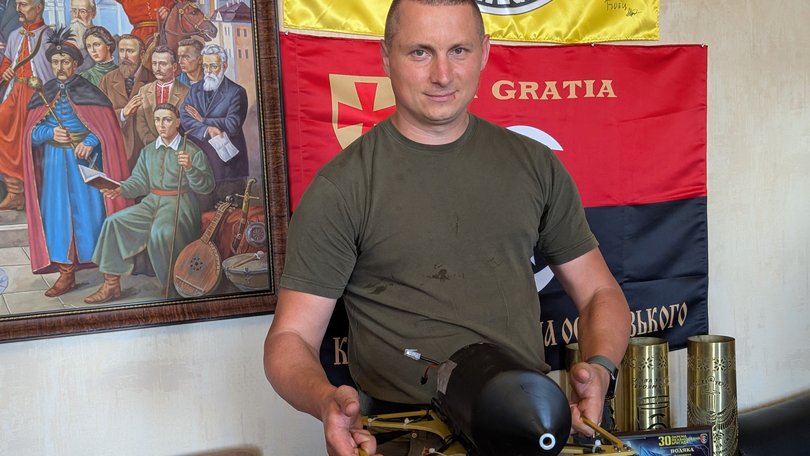
Zviahel, northern Ukraine: Artur Zahryviy presents what looks like the product of a high-school science experiment.
He holds a thin metal square frame with four rotors on each corner, dressed with electric wires fixed down by a bunch of cheap white plastic cable ties.
But the black, pointed tube on top, cut in half with some red and blue wires attached with electrical tape, speaks to its lethal intent.
Sign up to The Nightly's newsletters.
Get the first look at the digital newspaper, curated daily stories and breaking headlines delivered to your inbox.
By continuing you agree to our Terms and Privacy Policy.It is a Russian first-person-view (FPV) drone that costs around $500 to produce.
A soldier from Zviahel who has just returned from fighting on the frontline with his local brigade, and whose identity is being withheld for security reasons, has seen them in action.
“If this thing hits a tank, there will be no tank,” he tells The Nightly, speaking through a translator.
It is a sobering ratio to consider. For example, Australia’s donation of Abrams tanks, which have just begun to reach Ukraine, cost $245 million.
Even accounting for the cost of getting the tanks from Australia to Ukraine, it is staggering that a drone costing as little as a few hundred dollars can take out a tank that, in the case of the Abrams, cost Australia $10 million each when they were purchased in 2004.
The cost of taking lives in the Russia-Ukraine war has become cheaper than ever, three and a half years after Russian President Vladimir Putin launched his full-scale invasion in February 2022.
Mr Zahryviy, 38, head of the Zviahel District Council, says the weapon he is holding has redefined how Ukrainians experience the war and try to dodge death.
“Now the war has changed, it’s very automated, drones are in a very high quantity,” he says, also speaking through a translator, from his office.
“Right now, drones and specifically kamikaze drones are terrorising the front.”
He says three equally inexpensive things can be the difference between life and death.
“Nets, drones and pickups,” he says.
Ukraine has been covering their precious tanks, tactically critical for making advances as opposed to defending, with nets to snare Russian drones. Lately, major roads have also been covered in mesh to protect drivers and their cargo beneath. The nets vary in type and can be made from fishing or chicken wire, or, incredibly, even the type used in home gardens to protect cucumbers from pests.
As has been the case throughout the war, the Russians are also innovating and using the same net protection tactics.
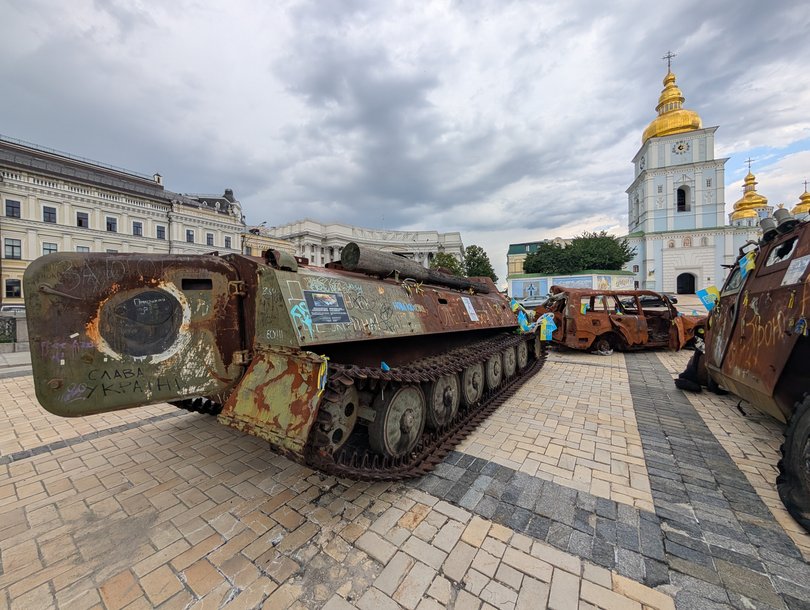
Russia continues to outnumber Ukraine’s forces and ramped up the pace of its advances on the frontline this year, occupying 500 square kilometres in June, according to the Ukrainian site DeepState. The site stated that Russia held those gains in July.
This is why his other need is for 4WDs.
“Such vehicles are very important to be able to evacuate people from the danger zones, and especially wounded people to the first point of medical aid,” he says.
“The vehicles are thus even more important now because of the need for mobility at the front line.”
“My citizens are always coming to me looking for help.”
Artur Zahryviy, in turn, looks abroad for help.
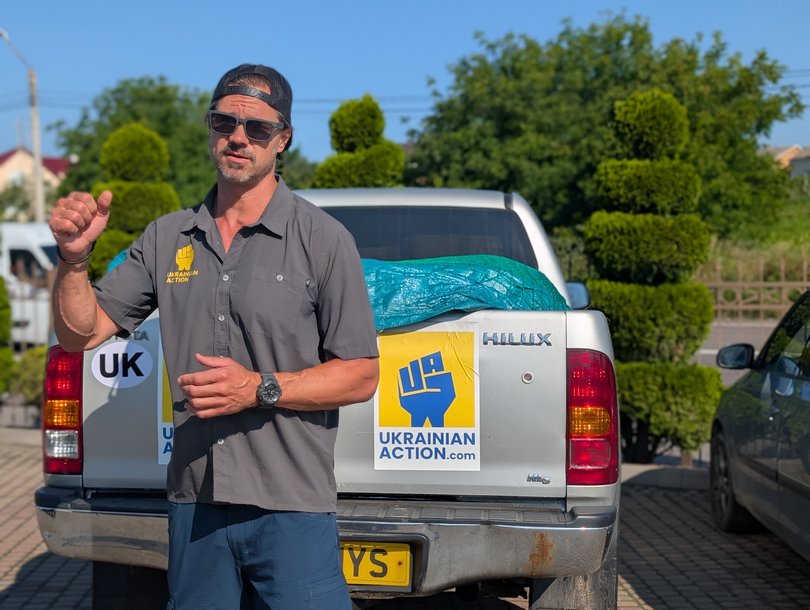
American Jeffrey Hartman first came to Ukraine in 2002 as part of the US Peace Corps. He is married to an Australian-Ukrainian woman, and together, they run a major international charity — Ukrainian Action — that sources, purchases, and delivers utes to Ukrainians on the frontline.
Today he is delivering two of five trucks driven by a team of volunteers from the UK, including The Nightly, over four sweltering days, starting in London, across the English Channel and through France, Belgium, Germany, Poland and to Kyiv via the Western city of Lviv.
The road trip is epic, on more than one night sleep is limited to just a few hours and in Lviv, interrupted by continuous air-raid alerts.
The utes are nothing fancy; one has 22,000 miles or 35,405 kilometres on it. They lack air conditioning and even a working radio.
It’s no joyride, but jammed in the back, amid boxes of aid and the one carry bag each volunteer is allowed to bring, it feels tremendously purposeful.
And even more so when supporters, noticing the Ukrainian Action stickers plastered on the sides and back, give an encouraging wave, or as was the case at Dover Port, staff stop and ask how they can get involved.
In the back of the truck are boxes of medical aid that may be the difference between someone keeping a limb or not.
In Poland, a bunch of tyres that Ukrainian-born Poles who have been scouring caryards are added to the load.
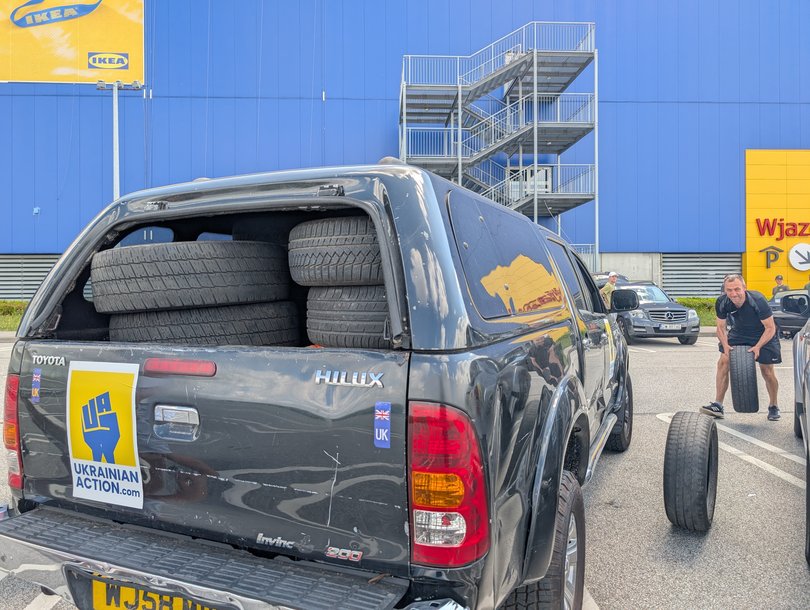
Dated and clapped out to some, the utes and their cargo are precious to the Ukrainians on the receiving end.
“They are a realistic life-saving instrument for our people,” Mr Zahryviy says.
When asked how he feels when he sees the trucks and aid arrive bearing the flags of supportive countries - in this case, the UK’s Union Jack, he says: “We realise we are not the only ones in this war.”
“Russia is a big country and without international help from places like the UK and US, we would not be in this position, and the war might have been over by now,” he says.
Mr Hartman was starting a new job in London when the full-scale invasion happened.
Watching his friends, “ the last guys that you think would ever be soldiers,” take up arms and don military uniforms left him with a sense of helplessness, until one told him that what they needed was a pick-up truck.
Mr Hartman purchased a ute from Facebook Marketplace and by early March was on his way to Poland, squeezing in the five-nation drive into his weekend.
It was the first of now 77 convoys to deliver a total of 392 trucks, with a 78th just started.
“The turning point was in December of 2022 when I drove two vehicles to Kharkiv in the middle of winter, loaded with generators, and we delivered these to city officials to provide generators to their power city heating facility,” he says.
“And I saw at that time, the look in their eyes, the gratefulness for the generators, for the vehicles to protect their city.”
He recounts another story where, in Pokrovsk, a civil service worker attempted to evacuate people from the village, which was about to be attacked.
The man was hit two times by Russian drones, and both his vehicles were destroyed. He survived the dual attacks and persevered with his mission.
”He went back to Pokrovsk, as he arrived, so did one of our volunteers in a pickup truck that we were donating,” Mr Hartman told the Latika Takes podcast during an interview in Kyiv.
“He took this pickup truck and he tried to complete this mission a third time.
“He did not get hit by an FPV drone.
“He evacuated 100 people from this town before it was attacked.”
It is stories like these that mean the role of vehicles looms large in Ukraine’s wartime mind.
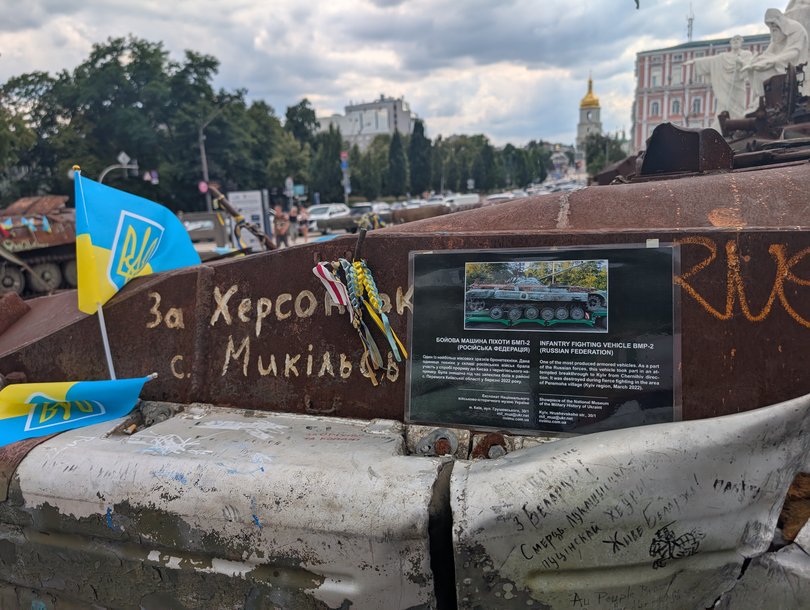
At Saint Michael’s Square, in front of the capital’s famous golden-domed Saint Michael’s monastery, is Kyiv’s Freedom wartime exhibition, displaying damaged Russian tanks but also vehicles used to rescue Ukrainians.
Mr Hartman had hoped around nine months ago that his services would not be needed for much longer.
But with the realisation that the war has evolved into a permanent struggle against Russian imperialism setting in across Ukraine, he concedes that he will be doing the job far longer than planned.
“There was a period of time, I would say last year, where we sort of plateaued with our activities and we were cruising at a healthy sort of 10 vehicles a month or so,” he says.
“Now it’s clear that we need to just continue trying to add efficiencies everywhere we can and continue building the operation because I feel like it’s going to be needed for a very long time.
“ We’ll do it basically as long as it takes, as long as we can.”
As part of volunteering to drive vehicles to Ukraine, Latika is required by Ukrainian Action to fundraise £1500 (AU$3075). If you would like to contribute, you can donate at Just Giving here.

